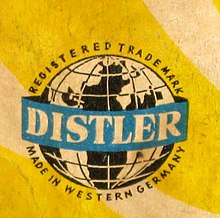Johann Distler
Johann Distler was a German manufacturer of tin toys .
The company, whose full name was Metallwarenfabrik Johann Distler KG , was founded around 1895 in Nuremberg . Until 1914, mainly cheap small toys without a drive mechanism were manufactured.
In the 1920s and 1930s the company expanded its product range considerably and now also offered more elaborate toys with clockwork drives. The car models were particularly successful ; in addition, planes and mechanical figures were also made. In the years between the First and Second World War , the number of Distler employees increased from 50 to 120, and the delivery program comprised 800 different items. In 1936 the Jewish owners had to sell the Distler company to Ernst Voelk , who also took over Trix in 1938 . Voelk insisted on a clear separation of the ranges: while Trix manufactured high-quality model railways and metal construction kits , Distler should round off the range with cars and simpler toys.
After the Second World War the company came with the made of sheet metal Porsche 7500 again a sales success: the model of 1955 produced a Porsche 356 - Convertible is equipped with the ignition key and remote control with spiral wire (steering wheel and two-speed transmission with reverse gear) today highly sought after as a collectible . The car model was powered by the double ball-bearing, bell-armature electric motor developed by Distler, which, thanks to its high level of efficiency, consumed extremely little electricity, so that very long running times were achieved.
In the 1950s, simple sheet metal railways continued to be built for the H0 gauge, which were mainly offered in department stores and mail order houses. There, too, the high-performance engine already mentioned in the paragraph (often referred to as the Distler engine in collectors' circles) was used. In addition to the trains for the H0 gauge, the company manufactured a smaller range for the larger 0. It is worth highlighting a three-phase drive, for which an approximate three-phase alternating current of 14 V was generated via a special transformer.
Serious market changes led to the decline of the company at the end of the 1950s, as Distler was unable to assert itself against the competition from larger manufacturers such as Schuco with its higher-quality products , while at the same time cheap, unattractive toy trains with clockwork and later also battery drives had to be manufactured, which did not collided with the Trix range, but for which there was no longer any demand.
Production was stopped in 1962. The manufacturing facilities and trademark rights were sold to Belgium , where some items, including the Porsche model, were manufactured until 1968 by a newly founded company called Distler Toys SA in Nivelles .
literature
- Gustav Reder : With clockwork, steam and electricity. From toys to model trains . Alba-Buchverlag, Düsseldorf 1970
- Rudger Huber: tin toys. Cars - motorcycles . Weltbild 1995. ISBN 3-8289-0794-6

